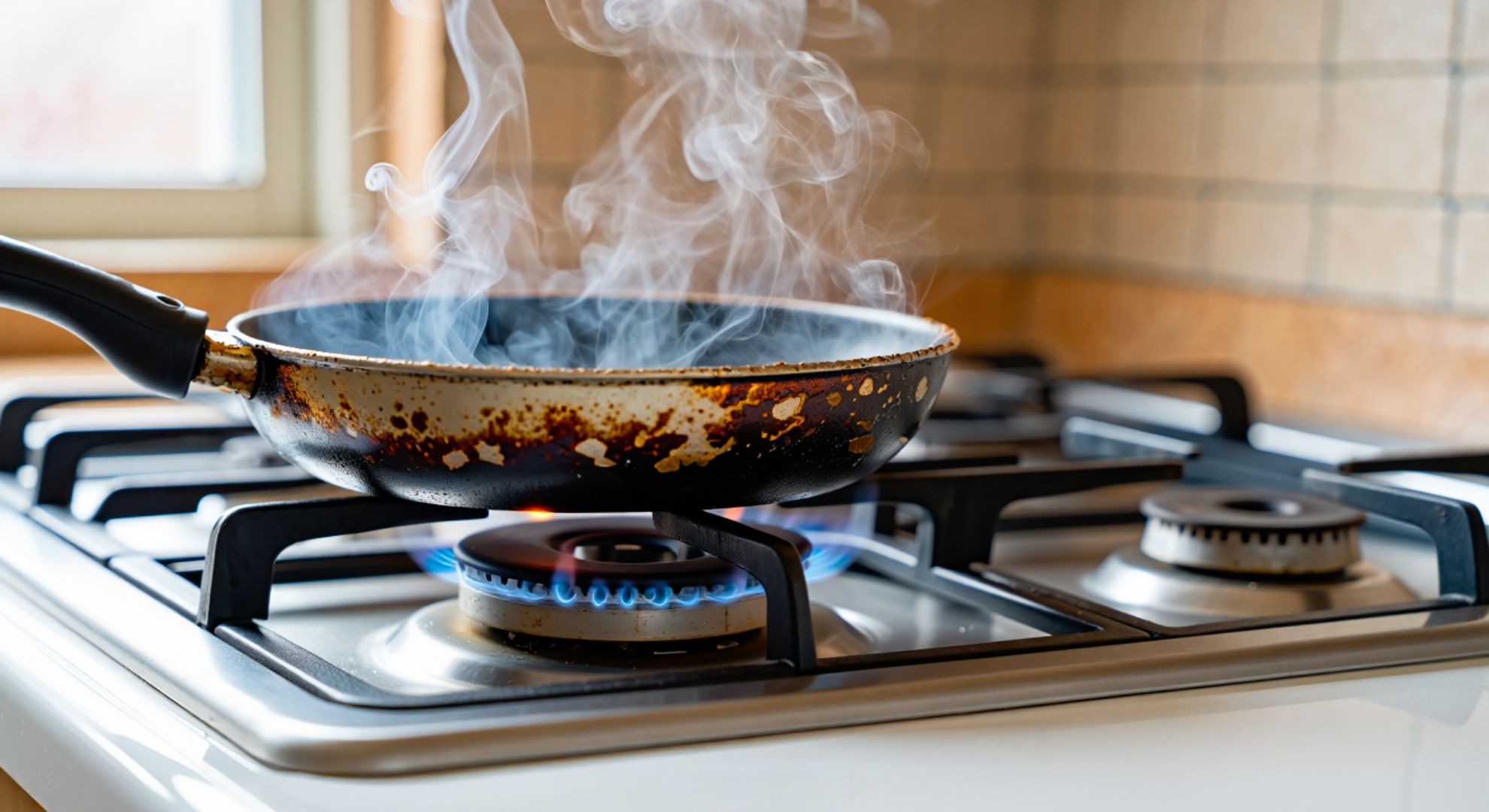You hear the sizzle, smell the butter, and think breakfast. But on a too-hot burner, a budget pan can turn into a problem. Thin construction and weak coatings mean heat climbs fast, and the air above your stove can fill with invisible byproducts you don’t want to breathe.
Some fumes are merely irritants. Others, in high enough doses, are linked to headaches, chills, and flu-like symptoms known as polymer fume fever. Birds are especially sensitive, sometimes fatally so. “If your canary would hate your kitchen, you probably need a cooler flame,” said one home-cook who learned the hard way.
What actually happens when it overheats
Many low-cost non-stick pans rely on PTFE, the slick polymer often known by a brand name. When kept under roughly 260°C (about 500°F), it behaves well. Push past that threshold, and it can degrade. At around 350°C (about 660°F), breakdown accelerates, releasing fumes that can irritate lungs and eyes.
Cheap pans hit those numbers more easily. A thin base heats unevenly. Hot spots form under a small flame. An empty pan can rocket to dangerous temperatures in minutes. “Most kitchen problems happen before the food is even in the pan,” a materials expert often reminds students.
Why the cheapest pans run hotter
Price often tracks engineering. Low-cost pans may skimp on thickness, limit the number of coating layers, and skip heat-diffusing discs. The result is a pan that’s light, fast, and unforgiving. You turn the knob a little higher, the pan leaps a lot hotter.
Higher-end PTFE pans use thicker aluminum, sometimes with a stainless plate for induction or better distribution. That extra mass buys time. Heat spreads, peaks flatten, and the surface stays closer to your setting.
What about ceramic, cast iron, and stainless steel
Non-stick is not a monolith. “Ceramic” coatings are typically silica-based, not PTFE. They won’t off-gas PTFE breakdown fumes, but they can still smoke oils at high heat, and their slickness tends to fade sooner. Cast iron is nearly indestructible, excels at searing, and doesn’t have polymer fumes—but it can smoke oils quickly and needs regular seasoning. Stainless is durable and versatile, though it’s less stick-resistant without proper technique.
Quick comparison of common options
| Pan Type | Typical Max Practical Temp | Pros | Cons | Price Range | Oven-Safe |
|---|---|---|---|---|---|
| Budget PTFE Non-stick | ~260°C/500°F surface | Very slick, very light | Overheats fast, coating wears quicker | $ | Limited |
| Premium PTFE Non-stick | ~260°C/500°F surface | Better heat distribution, longer life | Costs more, still temp-limited | $$–$$$ | Often |
| Ceramic-Coated Non-stick | ~230–260°C/450–500°F | PTFE-free, good initial release | Release fades faster, chips if dropped | $–$$ | Often |
| Cast Iron | 260°C+ (well beyond) | Rugged workhorse, superb sear | Heavy, needs seasoning, can smoke oils | $–$$$ | Yes |
| Stainless Steel (Clad) | 260°C+ (well beyond) | Durable, multi-purpose | Stick risk without proper preheat | $$–$$$ | Yes |
Note: Any pan can produce irritating smoke from burning oils; that’s separate from polymer fumes.
Smart habits to keep temp under control
Even with an inexpensive pan, you can cook safer.
- Preheat on low-to-medium heat, never empty for long; add oil or food to stabilize temperature; use ventilation or open a window; keep pet birds out of the kitchen; avoid searing on non-stick—use cast iron or stainless for high-heat tasks; replace scratched or flaking coatings; if something smells sharp or chemical, turn off the burner and ventilate immediately
“Medium is the new high,” a chef taught me years ago. On modern stoves, even medium can be plenty.
How to pick a safer non-stick
If you prefer the easy release of non-stick, look for heavier bases and clear temperature ratings. Multi-layer coatings with reputable brands tend to last longer and tolerate everyday mistakes. Check for an induction-capable plate if you use magnetic hobs; that plate often signals better construction.
Ask for oven limits in degrees, not vague claims. A lid and handle rated to at least 200°C (about 400°F) gives you more flexibility. If you see peeling edges or chalky patches, retire the pan; a failing surface heats unevenly and can shed flakes into food.
The bottom line at the stovetop
With good ventilation, moderate heat, and the right job for the right pan, you can keep breakfast calm and the air cleaner. Save the screaming-hot sear for materials that welcome it. Keep the slick, budget-friendly skillet for eggs, pancakes, and delicate fish.
Your kitchen should smell like butter and thyme, not like a hot factory. “Heat is a tool, not a dare,” as one instructor likes to say. Treat it with respect, and your gear—and your lungs—will thank you.
